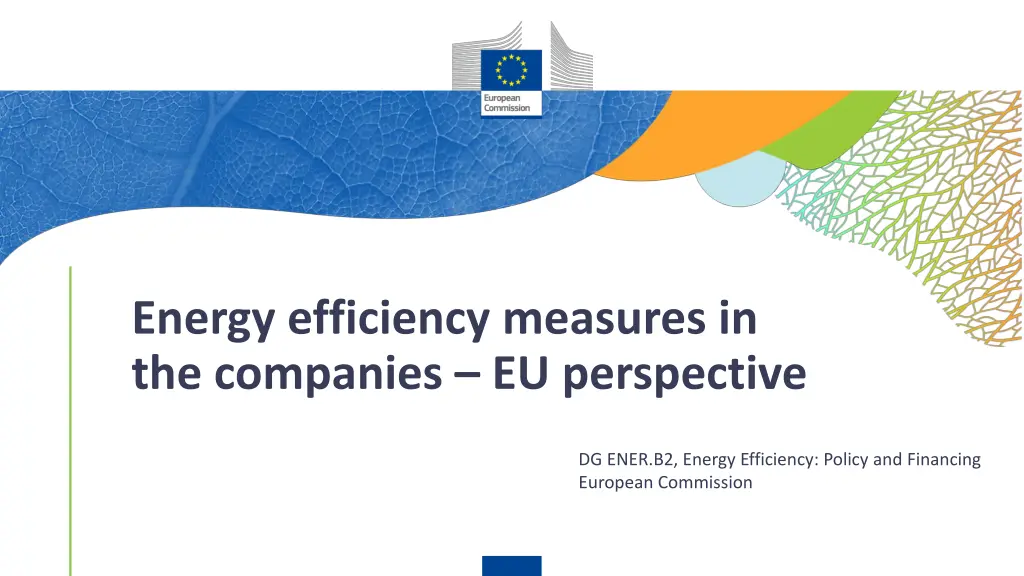
Energy Efficiency Measures in Companies: EU Perspective on Key Priorities and EED Revision
Discover the EU's key priorities for energy efficiency measures in companies to achieve climate neutrality by mid-century. Learn about the main elements of the Energy Efficiency Directive revision and the focus on energy management systems and audits in industries.
Download Presentation

Please find below an Image/Link to download the presentation.
The content on the website is provided AS IS for your information and personal use only. It may not be sold, licensed, or shared on other websites without obtaining consent from the author. If you encounter any issues during the download, it is possible that the publisher has removed the file from their server.
You are allowed to download the files provided on this website for personal or commercial use, subject to the condition that they are used lawfully. All files are the property of their respective owners.
The content on the website is provided AS IS for your information and personal use only. It may not be sold, licensed, or shared on other websites without obtaining consent from the author.
E N D
Presentation Transcript
Energy efficiency measures in the companies EU perspective DG ENER.B2, Energy Efficiency: Policy and Financing European Commission
Key priorities for energy (2024-2029) Secure(d) supplies of clean and affordable energy, for: European competitiveness and security Decarbonisation efforts towards 2030; and Climate neutrality by mid-century Mission Letter for Commissioner for Energy and Housing Implementation and delivery of the 2030 framework Fit for 55 package to stay on track with our common targets- Delivering the Green Deal and key legislations EED, EPBD, RED Key objectives: Bringing down energy costs, upgrading grid infrastructures, boosting renewables and energy efficiency, bolstering energy security, attract investments, address energy poverty and ensuring a just transition, and completing a robust Energy Union 2
Main elements of the EED revision Directive (EU) 2023/1791 entered into force on 10 October 2023 with a transposition period of 2 years Binding and increased EU energy efficiency target & indicative national contributions Energy Efficiency First Principle making it an integral part of policy and investment decisions Strengthened energy savings obligation in end-use Stronger exemplary role of public sector Increased focus on alleviating energy poverty and consumer empowerment 3
Article 11: Energy efficiency in industry Article 11(1) EED: Energy management systems Enterprises with an average annual consumption higher than 85TJ of energy over the previous 3 years and taking all energy carriers together Main criterion: energy consumption Article 11(2): Energy audits Every 4 years for enterprises with an average annual consumption higher than 10TJ of energy over the previous 3 years and taking all energy carriers together that do not implement an energy management system 4
Article 11: Energy efficiency in industry Article 11 (2): The recommendations from the energy audit shall result in a concrete and feasible Action Plan Action Plan, along with the recommendation implementation rate, to be published in an enterprise s annual report* *except information subject to national and EU laws protecting trade and business secrets and confidentiality Action Plan shall identify measures to implement each and every energy audit recommendation, where technically and economically feasible. 5
EED recast Article 11 Recommendation 1. Presents the key terms used for the purpose of Article 11 EED recast 2. Explains the methodologies for the calculation of the average annual energy consumption of the enterprises, along with concrete calculation examples 3. Presents the possible methodologies for the identification of the enterprises under the obligation under Article 11(1) and (2) by the Member States 6
EED recast Article 11 Recommendation 4. Presents the modalities for the preparation and publication of an Action Plan by the enterprises 5. Clarifies additional criteria for energy audits under Annex VI to be incorporated in the energy audit 6. Presents the tools and actions that can be used for the purpose of fulfilling Article 11(6) and (7) obligations as regards SMEs 7. Explains the exemptions from the Article 11(1) and (2) obligations 7
Financing energy efficiency Additional investment needed to achieve the 2030 target: 215bn National Energy Efficiency Funds Private investments Innovative financial schemes Cost-effective public support Article 30 EED 8
The Action Plan for Affordable Energy 4 Pillars, 8 Actions Action 1: Making electricity bills more affordable Action 2: Bring down the costs of electricity supply Action 5: Completing the Energy Union Action 3: Improve gas markets for fair energy prices Action 4: Energy efficiency: delivering energy savings Action 7: Security of supply for price stability Action 6: A tripartite contract for affordable energy for Europe s industry Action 8: Price crisis preparedness 9
The Action Plan for Affordable Energy European Energy Efficiency Financing Coalition Guarantee scheme with the EIB Action 4 Energy savings certification scheme Action Plan for Affordable Energy Clean Industrial Deal Partnership Electrification Action Plan Action 5 Heating and Cooling Strategy 10
Thank you DG ENER.B2, Energy Efficiency: Policy and Financing European Commission




















